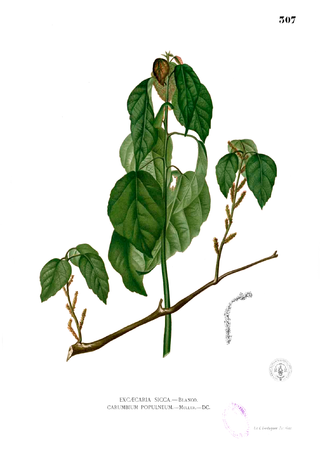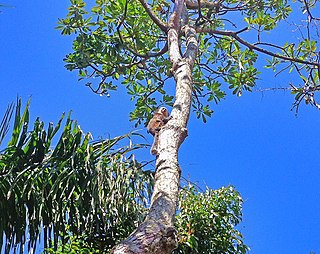
Hevea is a genus of flowering plants in the spurge family, Euphorbiaceae, with about ten members. It is also one of many names used commercially for the wood of the most economically important rubber tree, H. brasiliensis. The genus is native to tropical South America but is widely cultivated in other tropical countries and naturalized in several of them. It was first described in 1775.

Alchornea is a plant genus of the family Euphorbiaceae first described as a genus in 1788. It is widespread in tropical and subtropical regions of Africa, South Asia, Australia, Latin America, and various oceanic islands. Molecular phylogenetic analyses suggest that Bocquillonia from New Caledonia is nested in Alchornea.
Aparisthmium is a plant genus of the family Euphorbiaceae first described as a genus in 1840. It contains only one known species, Aparisthmium cordatum, native to South America and Costa Rica.
Adenophaedra is a plant genus of the family Euphorbiaceae first described as a genus in 1874. It is native to tropical regions of South America and Central America.
- Adenophaedra cearensis Secco - Ceará
- Adenophaedra grandifolia (Klotzsch) Müll.Arg. - Costa Rica, Panama, Colombia, Venezuela, Guyana, French Guiana, Ecuador, Peru, NW Brazil
- Adenophaedra megaphylla (Mull.Arg.) Mull.Arg. - Colombia, Ecuador, Peru, Suriname, E Brazil

Alchorneopsis is a genus of flowering plants in the family Euphorbiaceae first described as a genus in 1865. It is native to Central America, the Greater Antilles, and northern South America.
- Alchorneopsis floribunda(Benth.) Müll.Arg. - Costa Rica, Honduras, Panama, Puerto Rico, Dominican Republic, 3 Guianas, Colombia, Venezuela, Ecuador, Peru, NW Brazil
- Alchorneopsis portoricensisUrb. - Puerto Rico

Tetrorchidium is a genus of flowering plants in the family Euphorbiaceae first described in 1841. It is native to tropical portions of Africa and the Western Hemisphere.

Sagotia is a genus of plants under the family Euphorbiaceae first described as a genus in 1860. It is native to northern South America.
Micrandra is a plant genus of the family Euphorbiaceae first described in 1854. It is native to South America.

Mabea is a plant genus of the family Euphorbiaceae first described in 1775. It is native to Central and South America as well as Mexico and Trinidad.

Pouteria is a genus of flowering trees in the gutta-percha family, Sapotaceae. The genus is widespread throughout the tropical Americas, with outlier species in Cameroon and Malesia. It includes the canistel, the mamey sapote, and the lucuma. Commonly, this genus is known as pouteria trees, or in some cases, eggfruits.

Himatanthus is a genus of flowering plant in the family Apocynaceae, first described as a genus in 1819. It is native to Panama and South America.
- Himatanthus articulatus(Vahl) Woodson - widespread from Panama east to French Guiana and south to Bolivia
- Himatanthus attenuatus(Benth.) Woodson - Venezuela, Colombia, N Brazil
- Himatanthus bracteatus(A.DC.) Woodson - Venezuela, Colombia, Guianas, Brazil, Peru, Ecuador
- Himatanthus drasticus(Mart.) Plumel - Guianas, Brazil
- Himatanthus lancifolius(Müll.Arg.) Woodson
- Himatanthus obovatus(Müll.Arg.) Woodson - Brazil, Bolivia, Guyana
- Himatanthus phagedaenicus(Mart.) Woodson - S Venezuela, NW Brazil
- Himatanthus semilunatusMarkgr. - Amazon Basin
- Himatanthus stenophyllusPlumel - Colombia, NW Brazil, Guyana, Suriname
- Himatanthus tarapotensis(K.Schum. ex Markgr.) Plumel - Colombia, Bolivia, Brazil, Peru, Ecuador

Micropholis is group of trees in the family Sapotaceae, described as a genus in 1891.
Forsteronia is a genus of plants in the family Apocynaceae, first described as a genus in 1818. It is native to South America, Central America, Mexico, and the West Indies.
Malouetia is a genus of plants in the family Apocynaceae, first described as a genus in 1844. It is native to Africa, South America, Central America, and the West Indies.

Chomelia is a genus of flowering plants in the family Rubiaceae. It is native to Mexico, Central America, the West Indies, and much of South America as far south as Argentina.

Lacmellea is a genus of flowering plants in the family Apocynaceae first described as a genus in 1857. It is native to South America and Central America.
- Lacmellea abbreviataJ.F.Morales - Colombia
- Lacmellea aculeata(Ducke) Monach - Peru, NW Brazil, the Guianas
- Lacmellea arborescens(Müll.Arg.) Markgr. - Brazil, Bolivia
- Lacmellea bahiensisJ.F.Morales - Bahia
- Lacmellea costanensisSteyerm. - N Venezuela
- Lacmellea densifoliata(Ducke) Markgr. - Pará
- Lacmellea edulisH.Karst. - Panama, Venezuela, Colombia, Ecuador, Peru, Brazil
- Lacmellea floribunda(Poepp.) Benth. & Hook.f. - Peru, NW Brazil, Suriname, French Guiana
- Lacmellea foxii(Stapf) Markgr. - Peru
- Lacmellea gracilis(Müll.Arg.) Markgr. - N Peru, NW Brazil
- Lacmellea guyanensis(Müll.Arg.) Monach - French Guiana
- Lacmellea klugiiMonach. - Peru
- Lacmellea macranthaJ.F.Morales - Ecuador
- Lacmellea microcarpa(Müll.Arg.) Markgr. - Colombia, S Venezuela, NW Brazil
- Lacmellea oblongataMarkgr. - SE Colombia, Ecuador, Peru
- Lacmellea panamensis(Woodson) Markgr. - Costa Rica, Panama, Colombia, Ecuador
- Lacmellea pauciflora(Kuhlm.) Markgr. - Brazil
- Lacmellea peruviana(Van Heurck & Müll.Arg.) Markgr. - Peru
- Lacmellea pygmaeaMonach. - Amazonas State in Venezuela
- Lacmellea ramosissima(Müll.Arg.) Markgr. - Colombia, S Venezuela, NW Brazil
- Lacmellea speciosaWoodson - Costa Rica, Panama, Colombia, Ecuador, Peru
- Lacmellea standleyi(Woodson) Monach. - Belize, Guatemala, Honduras
- Lacmellea utilis(Arn.) Markgr. - S Venezuela, Guyana
- Lacmellea zamoraeJ.F.Morales - Costa Rica

Odontadenia is a genus of plant in the family Apocynaceae, first described as a genus in 1841. It is native to southern Mexico, Central America, South America, and the West Indies.
- Odontadenia anomala(Van Heurck & Müll.Arg.) J.F.Macbr. - Peru, Bolivia
- Odontadenia campanulataJ.F.Morales - Colombia
- Odontadenia funigeraWoodson - Venezuela, Colombia, Ecuador, Peru, Brazil
- Odontadenia geminata(Hoffmanns. ex Roem. & Schult.) Müll.Arg. - 3 Guianas, Venezuela, Colombia, Ecuador, Peru, Bolivia, N Brazil
- Odontadenia glaucaWoodson - Amazonas State in S Venezuela
- Odontadenia gracilipes(Stadelm.) Woodson - Minas Gerais
- Odontadenia hypoglauca(Stadelm.) Müll.Arg. - Bolivia, Brazil
- Odontadenia killipiiWoodson - French Guiana, Venezuela, Colombia, Ecuador, Peru, N Brazil
- Odontadenia kochiiPilg. - Guyana, Venezuela, Colombia, Ecuador, Peru, N Brazil
- Odontadenia laxiflora(Rusby) Woodson - Peru, Bolivia, N Brazil
- Odontadenia lutea(Vell.) Markgr. - Peru, Bolivia, Brazil
- Odontadenia macrantha(Roem. & Schult.) Markgr. - Oaxaca, Chiapas, Central America, Trinidad & Tobago, 3 Guianas, Venezuela, Colombia, Ecuador, Peru, Brazil
- Odontadenia markgrafianaJ.F.Morales - French Guiana, N Brazil
- Odontadenia matogrossanaJ.F.Morales - Goiás, Mato Grosso
- Odontadenia nitida(Vahl) Müll.Arg. - Trinidad & Tobago, 3 Guianas, Venezuela, Colombia, Ecuador, Peru, Brazil, Bolivia
- Odontadenia perrottetii(A.DC.) Woodson - Venezuela, Colombia, Brazil, Bolivia, Guyana, French Guiana
- Odontadenia polyneura(Urb.) Woodson - Hispaniola
- Odontadenia puncticulosa(Rich.) Pulle - Central America, 3 Guianas, Venezuela, Colombia, Ecuador, Peru, Brazil, Bolivia
- Odontadenia stemmadeniifoliaWoodson - Venezuela, Colombia, Ecuador, Peru, Brazil
- Odontadenia verrucosa(Willd. ex Roem. & Schult.) K.Schum. ex Markgr. - 3 Guianas, Venezuela, Colombia, Ecuador, Peru, Brazil, Bolivia, Panama, Costa Rica, Nicaragua
- Odontadenia cuspidataRusby = Mandevilla cuspidata(Rusby) Woodson
- Odontadenia duckeiMarkgr. = Mandevilla pohliana(Stadelm.) A.H.Gentry
- Odontadenia glandulosa(Ruiz & Pav.) K.Schum. = Mandevilla glandulosa(Ruiz & Pav.) Woodson
- Odontadenia macrocalyx(Müll.Arg.) Miers = Tabernaemontana macrocalyxMüll.Arg.
Tassadia is a genus of plants in the family Apocynaceae, first described as a genus in 1844. It is native primarily to South America, with one species extending north into Central America, S Mexico, and Trinidad.

Pausandra is a plant genus of the family Euphorbiaceae first described in 1870. It is native to Central America and South America.
- Pausandra fordiiSecco - Amapá, French Guiana
- Pausandra hirsutaLanj. - Peru, Brazil, Bolivia (Pando), Colombia (Amazonas)
- Pausandra macropetalaDucke - Brazil, Peru (Loreto), Venezuela (Amazonas)
- Pausandra macrostachyaDucke - Pará
- Pausandra martiniBaill. - French Guiana, Suriname, Guyana, Colombia, Venezuela, Peru, Brazil
- Pausandra megalophyllaMüll.Arg. - Rio de Janeiro
- Pausandra morisiana(Casar.) Radlk. - Brazil
- Pausandra trianae(Müll.Arg.) Baill. - widespread from Honduras to Bolivia












